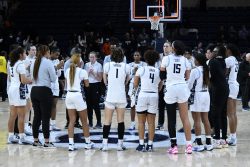After finishing last season with a 16-15 record, the Georgetown Hoyas would have been hard-pressed to find a fan or analyst who counted them among the top teams in the country. The NCAA Tournament Selection Committee certainly did not, leaving Georgetown out of the field of 65.
Although the team’s misery was apparent to most humans, it seems computers took a brighter view of the season: popular basketball rating site kenpom.com ranked the Hoyas as the 27th-best team in the nation at the end of last season.
Started by meteorologist Ken Pomeroy in 2004, the site’s rankings take statistics available in any box score and uses a number of formulas, from “offensive efficiency” (points scored per 100 offensive possessions) to strength of schedule (the average ranking of a team’s opponents) to project a team’s winning percentage.
Placing a squad that got knocked out in the first round of the National Invitation Tournament among the top 30 teams in the nation is bound to provoke some questions. Among the skeptics is head coach John Thompson III, who has never given much regard to statistical analysis.
“I coach by feel,” he said. “We can analyze the latter part of last year until the cows come home, or until I jump off the Key Bridge … whatever the ranking was, it wasn’t the standard where we need to be at both ends of the floor.”
So how does Pomeroy explain Georgetown’s bizarrely high ranking in his system? Part of the answer is that even during the Hoyas’ disintegration during the second part of last season, the team wasn’t getting blown out—it was playing statistically efficient, quality basketball against good teams. The Hoyas just couldn’t end up with actual wins.
Pomeroy’s system tries to account for these types of end-of-game woes with a metric he calls “luck.” Unsurprisingly, the Hoyas ranked 339th in luck last season, making them the sixth most unlucky team in the country. While this misfortune made for a frustrating season, Pomeroy sees it as a cause for optimism this year.
“Teams that have bad ‘luck’ one year usually do a lot better the next,” he said. “I think Georgetown’s a pretty good bet to surprise some people this year, because they probably will do a lot better in close games.”
But even Pomeroy cautions that statistical analysis has its limitations.
“It’s a reality check,” he said. “I wouldn’t recommend someone to draw conclusions from just watching, and I wouldn’t recommend drawing conclusions by strictly looking at the numbers.”
While stats-driven thinking has taken on a larger role in the way professional teams make decisions, it is far from universal in the college game. A big—and unavoidable—reason for that is the relatively small sample size of the college season. A good team will play around ten games in a given season against weaker opponents, leaving only about twenty games’ worth of relevant data. Pomeroy himself acknowledged that “it’s really tough to get a lot of meat out of the stats.”
That may be the case, but the truth in the statistics is apparent. Even the uninitiated understand what they are trying to evaluate.
“We’ve been extremely efficient at the offensive end,” Thompson said. “And for the most part, in the five years that I’ve been here, we’ve been pretty good at making the defense take tough contested shots.”
It seems the computers recognize that, even when the scoreboard doesn’t.




